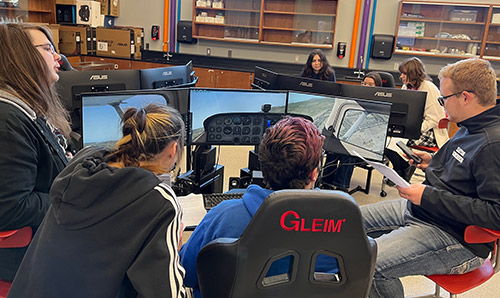According to the new 2023 Women in Tech report, 45 percent of women technologists say they are outnumbered by men in the workplace by 75 percent or more — a significant increase from the 25 percent who said the same in 2021. This is particularly the case within the aerospace industry. From stereotypes to biases, there is an undeniable perception of this male-dominated field that undermines the potential for female success. Breaking these patterns is crucial to empowering women in STEM and closing the gender gap.
In terms of STEM majors, only around 21 percent of engineering majors and around 19 percent of computer and information science majors are women, according to the American Association of University Women. In the aerospace workforce, as of 2021, 13.4 percent of the workforce is made up of women. According to the Pilot Institute, female pilots account for 9.57 percent of the total, with only 6.34 percent of that percentage being non-student female pilots.
In addition to the lack of diversity within the sector, there is a general workforce shortage nationally. Between 2021 and 2031, the United States will need 3,800 new aerospace engineers every year, according to the Bureau of Labor Statistics. These shortages are contributing to travel disruptions that we’re seeing throughout the world, but efforts to diversify the industry can help to alleviate the crisis and boost our economy.
In terms of STEM majors, only around 21 percent of engineering majors and around 19 percent of computer and information science majors are women.
But how do we solve this massive gender gap? From acknowledging the disparity to educating the youth on STEM opportunities and providing resources in partnership with stakeholders — it’s a multi-faceted approach.
Promoting STEM to youth must start early, even before grade-level education. To achieve this, community-based organizations like YMCA programs and Girl Scouts can serve as an essential starting point to incorporate STEM teachings at an early age. Programs of this kind should also roll into early childhood education and college levels — whether they be extracurricular programming for students, aviation-focused academies, or STEM training courses for teachers. Support at a state level is also a factor that helps to fund programs of these kinds.
Some Examples
As the deputy director of aerospace and defense at the Oklahoma Department of Commerce, my role has enabled me to bring attention to and support programs like these to help make them a reality.
Diversifying Oklahoma’s aerospace industry is imperative for our state, with it being our second-largest industry. We’re home to over 1,100 aerospace entities that employ 120,000. Eighteen Fortune 500 companies in the state are involved in aerospace, and two of the world’s largest MRO facilities are located here. Oklahoma is tackling this gender gap and the overall workforce shortage head-on — either through the deployment of K-12 STEM initiatives, upgrading curriculums across graduate and technical schools, and/or rolling out customized and complementary workforce training programs available to eligible companies. Concrete examples follow:
- In 2021, Oklahoma opened Camp Trivera, a $12 million-funded STEM camp that is designed to bring science and engineering, math and technology, and the arts to life while offering a fun, outdoor experience for Girl Scouts throughout the state.
- In support of Oklahoma’s teachers, Open for Business Oklahoma’s free “Think Like an Engineer” series offers six science, technology, engineering, art, and math (STEAM) lessons. Their content is designed to help middle school students put textbook concepts into hands-on practice.
- The Oklahoma Aerospace Commission (OAC) distributes $335,000 on an annual basis to fund programs statewide aimed at exposing more Oklahoma youth to STEM careers in the aerospace industry.
- Created by the Aircraft Owners and Pilots Association (AOPA), the “You Can Fly” program offers an aviation STEM curriculum for high schools across the United States. In 2022 Oklahoma had the highest number of high schools in the U.S. offering the AOPA program, rolled out across 56 high schools; that number is expected to rise to 80 in 2023.
- In 2022, Norman Public Schools launched the Oklahoma Aviation Academy, which is themed around aviation and aerospace. Students can graduate with a private pilot license and two years of complete coursework toward their bachelor’s degree in aviation, as well as certifications in UAS (drones). The program includes an MRO-focused curriculum created jointly by Embry Riddle Aeronautical University and ATEC (Aviation Technical Education Council).
The “You Can Fly” program offers an aviation STEM curriculum for high schools across the United States.
Aside from programming, progress can’t flourish without the acknowledgment of females within this sector. In 2017, the Oklahoma legislature passed Senate Bill 230 to officially recognize the contribution of Oklahoma women in the state’s aviation and aerospace industry.
Promoting these initiatives and aiming to close the gender gap in aviation and STEM fields will be our mission for decades to come. Breaking these barriers will not only benefit the aerospace/aviation sector but empower women, creating a positive chain reaction for our country’s aerospace ecosystem as a whole.

Created by the Aircraft Owners and Pilots Association (AOPA), the “You Can Fly” program offers an aviation STEM curriculum for high schools across the United States.
Credit: Source link
